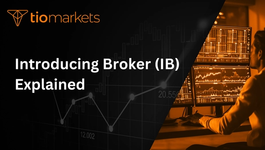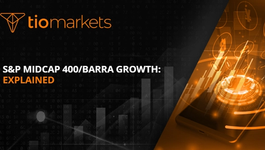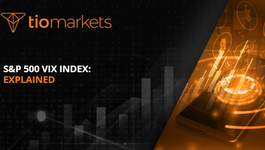Retail foreign exchange trading: Explained
BY TIOmarkets
|August 15, 2024Retail foreign exchange trading, also known as Forex trading, is a global marketplace for the trading of currencies. This form of trading involves buying, selling, and exchanging currencies at current or determined prices. In terms of trading volume, it is by far the largest market in the world.
Given the global nature of the currency markets, the Forex market operates 24 hours a day, five days a week. This is because there's always a financial center somewhere in the world that's open for business, and currencies are traded in every time zone. This makes it very attractive for traders who can trade markets around the clock.
Understanding Retail Forex Trading
Retail Forex trading is a segment of the larger foreign exchange market where individuals speculate on the exchange rate between different currencies. This market operates via a network of banks, businesses, and individuals trading one currency for another. But unlike the stock market, there is no central marketplace for foreign exchange. Rather, currency trading is conducted electronically over-the-counter (OTC), which means that all transactions occur via computer networks between traders around the world, rather than on one centralized exchange.
While traditionally, the Forex market was dominated by large financial institutions, with the advent of internet trading, it has become accessible to retail traders. Retail traders are individuals who trade Forex for their personal account, and not for a company or organization.
Role of Forex Brokers
In the retail Forex market, brokers act as the middleman between the retail trader and the interbank Forex market. Brokers offer platforms from which Forex traders can trade. They typically offer a range of services, including access to currency pairs, technical analysis tools, and leverage trading options.
Brokers make money through spreads and commissions. A spread is the difference between the bid price and the ask price for a particular currency pair. When a trader opens a position at a broker, they are immediately "in the negative" because they start from the value of the spread. They need the currency pair to move in their favor to make a profit.
Trading Platforms
Trading platforms are software applications that provide traders with access to the Forex market. They offer a range of features, such as real-time price feeds, charting tools, trade execution methods, and a suite of preloaded indicators. MetaTrader 4 and MetaTrader 5 are among the most popular trading platforms among retail Forex traders.
Trading platforms can be desktop-based, web-based, or mobile applications. Desktop platforms offer the most comprehensive features, but web-based and mobile platforms offer the convenience of trading from anywhere with an internet connection.
Types of Retail Forex Traders
Retail Forex traders can be categorized into several types based on their trading style and the strategies they use. The most common types include day traders, swing traders, and position traders.
Day traders are those who make multiple trades within a single day, with the aim of capturing small price movements. Swing traders hold positions for several days or even weeks, aiming to profit from short-term price patterns. Position traders, on the other hand, hold positions for longer periods, often months or years, with the aim of profiting from long-term price trends.
Day Traders
Day trading is a strategy that involves opening and closing all trades within a single day. No positions are held overnight. Day traders aim to make profits by taking advantage of small price movements in highly liquid markets, such as the Forex market.
Day trading requires a high level of knowledge, experience, and time commitment. It involves making quick decisions, and traders need to be able to stay calm and controlled under pressure. Day traders also need to have a solid understanding of technical analysis and charting, as these are crucial in identifying potential trading opportunities.
Swing Traders
Swing trading is a style that aims to capture gains in a market within a span of a few days to several weeks. Swing traders utilize various strategies to find and take advantage of these opportunities.
Swing trading involves holding positions for a longer period than day trading, and therefore, requires a higher level of patience and discipline. Swing traders need to have a good understanding of market fundamentals, as well as technical analysis, as both are important in this trading style.
Understanding Forex Pairs
In the Forex market, currencies are traded in pairs. Each pair represents the value of one currency against the value of another. The first currency in a pair is called the base currency, and the second currency is called the quote currency.
For example, in the EUR/USD pair, EUR is the base currency and USD is the quote currency. If the price of this pair is 1.2000, it means that 1 euro (the base currency) is worth 1.20 US dollars (the quote currency).
Major, Minor, and Exotic Pairs
Forex pairs are categorized into major, minor, and exotic pairs. Major pairs are those that include the US dollar as one of the currencies. These pairs are the most traded pairs in the Forex market, and they include pairs like EUR/USD, USD/JPY, and GBP/USD.
Minor pairs, also known as cross-currency pairs, are pairs that do not include the US dollar. These pairs include EUR/GBP, EUR/CHF, and GBP/JPY. Exotic pairs, on the other hand, include a major currency and the currency of a developing economy, such as USD/SGD, USD/ZAR, or USD/THB.
Risks and Challenges in Retail Forex Trading
While retail Forex trading offers the potential for high profits, it also comes with high risks. One of the biggest risks in Forex trading is leverage. Leverage allows traders to control a large amount of money with a small initial deposit, known as margin. While this can amplify profits, it can also amplify losses.
Other risks include market risk, as the Forex market is influenced by various factors that can cause price fluctuations. These include economic data releases, policy decisions by central banks, geopolitical events, and market sentiment. There's also the risk of loss from trading platforms and systems, as well as the risk of fraud from unregulated brokers.
Managing Risks
There are several ways to manage risks in Forex trading. One of the most common methods is through the use of stop loss orders. A stop loss order is an order placed with a broker to buy or sell a security when it reaches a certain price. It is designed to limit a trader's loss on a position.
Another way to manage risk is through diversification. This involves spreading investments across various financial instruments to reduce exposure to any one asset. Traders can also manage risk by only trading with money they can afford to lose, and by thoroughly researching and understanding the Forex market before starting to trade.
Conclusion
Retail Forex trading is a complex and high-risk activity that involves speculating on the price movements of currency pairs. While it offers the potential for significant profits, it also carries significant risks. Therefore, it is important for individuals interested in this form of trading to educate themselves, develop a trading plan, and learn to manage their risks effectively.
With the right knowledge, tools, and mindset, retail Forex trading can be a rewarding way to achieve financial goals. However, it is not suitable for everyone, and potential traders should carefully consider their financial situation and risk tolerance before engaging in Forex trading.
Start Trading with TIOmarkets
Ready to step into the world of Forex trading? Join TIOmarkets, a top-rated broker with over 170,000 accounts opened across more than 170 countries. Our online trading platform offers you the opportunity to trade over 300 instruments across 5 markets, including Forex, indices, stocks, commodities, and futures, all with low fees. Enhance your trading skills with our comprehensive educational resources and step-by-step guides. Take the first step towards achieving your financial goals by creating a Trading Account today.

Risk disclaimer: CFDs are complex instruments and come with a high risk of losing money rapidly due to leverage. You should consider whether you understand how CFDs work and whether you can afford to take the high risk of losing your money. Never deposit more than you are prepared to lose. Professional client’s losses can exceed their deposit. Please see our risk warning policy and seek independent professional advice if you do not fully understand. This information is not directed or intended for distribution to or use by residents of certain countries/jurisdictions including, but not limited to, USA & OFAC. The Company holds the right to alter the aforementioned list of countries at its own discretion.
Join us on social media

Behind every blog post lies the combined experience of the people working at TIOmarkets. We are a team of dedicated industry professionals and financial markets enthusiasts committed to providing you with trading education and financial markets commentary. Our goal is to help empower you with the knowledge you need to trade in the markets effectively.





